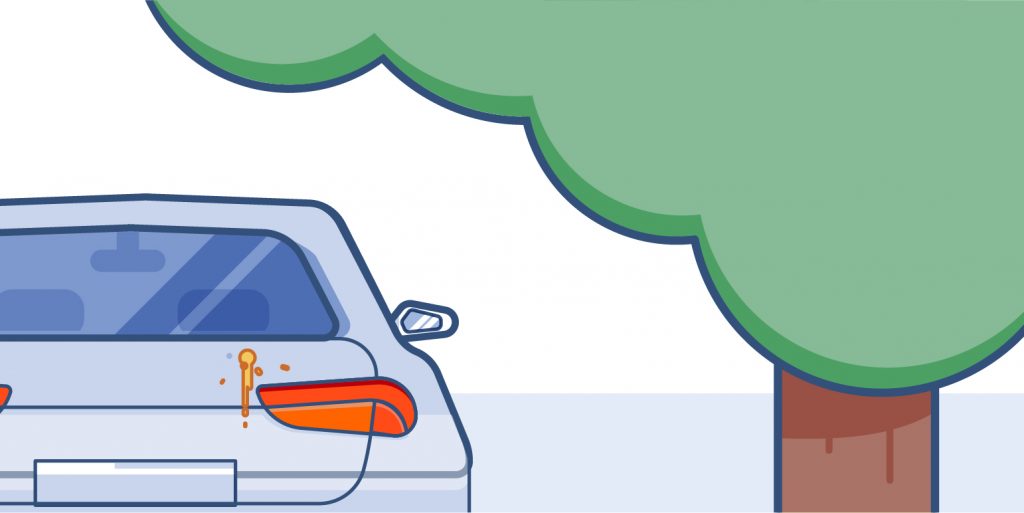In the process of reading this article, you’ll learn why tree sap can damage to your car, and—if you’re already dealing with this issue—you will be provided with a step-by-step guide how to remove tree sap from the surface of your vehicle.
We will cover the best methods for tree sap removal, and discuss the best products on the market that you can use to remove this often infuriating substance yourself if you do decide to go the DIY route.
Although this process may seem very challenging, rest assured that selecting the right products and following our thorough guide will have your car absolutely shiny in no time.
TABLE OF CONTENTS
I. What is Tree Sap?
II. How can Tree Sap Damage your Car’s Paint Job?
III. Best Tree Sap Removal Products
IV. How to Remove Tree Sap From Your Car
I. What is Tree Sap?
Tree sap is equivalent to the “blood” of trees. It contains myriad minerals and nutrients necessary for the tree’s survival, as well as the energy that supports trees’ growth and functioning. (You may be most familiar with tree sap in the form of maple syrup, which made from the sap of maple trees—drilled from the trees and then boiled down into a concentrated and very sweet liquid.)

There are two different liquids found within trees that are referred to as “sap.” The first is xylem, which moves water, hormones, and minerals through the tree from bottom to top. The second is phloem, which is the sticky substance that contains sugars generated by the tree’s photosynthesis (used by the tree to fuel growth)—the conversion of sunlight to energy.
Phloem is the kind of sap that will cause significant frustration when it gets on your car—all that sugar means it’s basically like glue. (In fact, people have used sap as glue in the past for that very reason.)
Tree sap leaking on the outside of a tree is often a sign of disease, damage or pest infestation; this is because trees extrude sap from any wounds on their surfaces, as it functions as a kind of “scab.”
It’s incredibly easy to recognize the presence of sap on your car—it’s very visually apparent in most cases.
You’ll see transparent or red-tinted bumps on the surface of your car. And once you’ve recognized the problem, there are ways to resolve it.
Keep reading to learn how.
II. How can Tree Sap Damage your Car’s Paint Job?
Tree sap really is one of the worst things that can happen to a vehicle’s paint. It’s extremely difficult to remove and can cause more damage than just about any other contaminant.

People often park their cars under trees to benefit from the shade they offer, but the potential effects of the sap that can drip from trees make this a bad idea all around.
Pine sap is exceptionally sticky and problematic. Sap drips onto the car, then “bakes” in the sun to solidify into a resin-like substance. It then eats away at the car’s clear coat and paint, so that every bit of sap has an area of damage around it. It’s almost impossible to wash off using standard car washing techniques, and cleaner waxes, and spray cleaners, and even solvents may be unable to remove this dried-on sap.
The damage that can accrue can be very costly, so it’s important to nip the problem in the bud before it becomes too overwhelming. The longer you leave sap on your car, the worse the paint damage will get.
III. What is the difference between Car Wax and Car Polish?
Before we go any further, let’s make sure that it’s understood that car polish and car wax are two very different things.
Car polish is used as a remedy. Polish removes the dirt, grime, grease, and scratches that are left behind after a good washing. Solvents within the polish allow it to remove, or at least reduce, impurities on the paint surface and will bring out the shine.
Car polish should be used in a multistage process of caring for your vehicle’s paint because, while it can make your car look great when finished, it does not seal or protect the paint. Waxing is the only true way to protect your car’s paint and should be completed after the polishing step.
III. Best Tree Sap Removal Products
These are some of the most powerful, effective products on the market for removing tree sap from your automobile and protecting its paint job:
1. Turtle Wax Bug and Tar Remover
This spray-on foam clings thoroughly to wide areas and works beautifully to dissolve not only sap but also tar and bugs. It functions as a pre-wash or spot cleaner and is formulated to be entirely streak-free. It can be used on paint, glass, metal, and plastic. It sprays as a foam, then becomes a liquid, which can be wiped or washed off leaving a sparkling clean surface with no residue.
2. Stoner Car Care Tarminator Bug, Tar, Sap, and Grease Remover
This spray uses MicroActive cleaning technology to quickly dissolve and break down sap (in less than 30 seconds) as well as bugs, tar, and grease on the surface of your car. It’s also specially designed to work on chrome and paint surfaces without damaging the finish of either material.
3. Swan Isopropyl Alcohol, 99 Percent
Some people say that high concentrations of isopropyl alcohol work better than any other substance to dissolve stuck-on sap. Better yet, it’s easy to find and has many different uses. If you’re thrifty and prefer a straightforward, versatile product, this is a great choice.
IV. How to Remove Tree Sap From Your Car
People will recommend plenty of methods to clean tree sap off of your car. But read on, because we’re offering you what we believe is the absolute best method for doing so.
1. Gather your supplies

You’ll need the following supplies, so make sure you have them all before you begin:
- Clean, soft towels or terry cloths
- A box cutter blade (for use on glass only—use this if you have sap on your car windows)
- Sap remover solution (such as Bug and Tar Remover) or rubbing alcohol
- Bucket of water
- Sponge/wash mitt
- Spray wax/quick detailer polish
2. Wash and dry your vehicle as usual
Use soap and hot water to clean your car, then dry it all off. By washing and drying your vehicle, you ensure that the steps that follow are as practical as they can possibly be.
If you get fortunate, you might even be able to remove the sap with this step, assuming it’s not terribly stuck on.
Additionally, washing your car before removing the sap means you’ll be able to see where all the sap is, and you’ll derive a lot more satisfaction from having a spotless car when you’re done with this process.
3. Locate the spots of sap
As we mentioned, the sap spots will be visible as typically hardened, clear or reddish raised areas. If they’ve been there for a while, they may have begun to eat into your car’s paint job and may also be surrounded by the areas of deterioration that are typical of the long-term presence of hardened sap.
4. Apply sap remover solution (or rubbing alcohol) to the sap spots

Now that you know where the sap is located, you can get into the nitty-gritty of removing it. Pour several drops of sap remover solution (such as Bug and Tar Remover) onto a clean washcloth or terrycloth.
If you don’t want to purchase this product, you can also try using rubbing alcohol, although it’s not designed for this purpose. Place the cloth on the sap and press it onto the area for a minimum of 30 seconds to one minute (the pressure will help the remover to soak into the sap).
After allowing the solution to work, you can begin to use some elbow grease to rub the sap away. Make sure you do so gently because otherwise, you can spread the sap around on the surface of your car, creating a more significant problem.
If the sap is really hardened on and isn’t coming off, you can repeatedly soak the area with more solution or rubbing alcohol, then manually rub it away, until you’ve gotten rid of it all.
5. Remove sap from your windshield/windows
If the sap got on your windshield or windows, first thing’s first: do not use your windshield wipers on fresh sap! It will just spread it around and leave you with messy streaks that are difficult to remove. Instead, you can follow the same steps above.
You can also use a box cutter blade to remove the most hardened pieces of sap from the glass. Just be careful, as these blades are quite sharp.
And be sure to keep the blade flat along the surface of the glass so that you don’t create scratches, which are quite unattractive and can impede visibility over time.
6. Finishing touches

Once you’ve gotten all the sap off of your car’s paint job and windows, spray quick wax onto the paint and clean it off with a detailing cloth. This will leave your car looking good as new with a beautiful finish.
The wax will make sure that the paint and clear coat are thoroughly protected, and that future damage is less likely.
Conclusion
Now that you’re aware of why sap is such a common problem—and one that can potentially ruin your car’s paint job if left too long—it’s a good thing you also know that it’s completely possible to fix.
Your car won’t be permanently stuck with patches of dried on resin; all you need is some essential products, time, and elbow grease, and you can save your car’s paint job and windows from the effects of sap.
And in the future, be sure to avoid parking under trees, and keep an eye out for any new patches of sap, since the longer they sit there, the harder they’ll be to remove.







